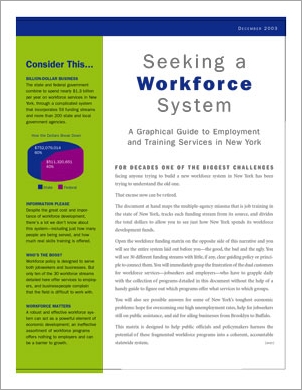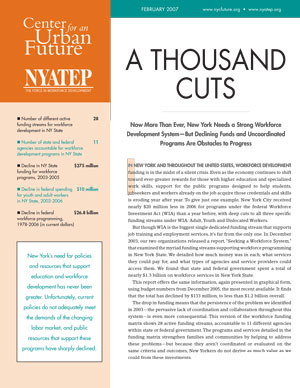This is an excerpt. Click here to read the full report (PDF).
For decades one of the biggest challenges facing anyone trying to build a new workforce system in New York has been trying to understand the old one.
That excuse now can be retired.
The document at hand maps the multiple-agency miasma that is job training in the state of New York, tracks each funding stream from its source, and divides the total dollars to allow you to see just how New York spends its workforce development funds.
Open the workforce funding matrix on the opposite side of this narrative and you will see the entire system laid out before you—-the good, the bad and the ugly. You will see 30 different funding streams with little, if any, clear guiding policy or principle to connect them. You will immediately grasp the frustration of the dual customers for workforce services—-jobseekers and employers—-who have to grapple daily with the collection of programs detailed in this document without the help of a handy guide to figure out which programs offer what services to which groups.
You will also see possible answers for some of New York’s toughest economic problems: hope for overcoming our high unemployment rates, help for jobseekers still on public assistance, and aid for ailing businesses from Brooklyn to Buffalo.
This matrix is designed to help public officials and policymakers harness the potential of these fragmented workforce programs into a coherent, accountable
statewide system.
The case for immediate action is clear. In September 2003, New York had a statewide unemployment rate of 6.3 percent-—with tens of thousands more out of work but not counted by the official measure. Workforce funding provides federal money to serve those looking for work with a menu of options, ranging from job counseling and help writing a resume to intensive skills retraining. Many state businesses also need training resources for incumbent workers, wage-subsidy assistance to increase workforce size, or other kinds of help to stay competitive in the current economy.
The long-term case for bolstering the state’s workforce network is that, in New York and nationally, the economy is slipping toward a silent crisis of rising skill needs and worker shortages.
In a 2001 National Association of Manufacturers survey, 80 percent of employer respondents mentioned experiencing a serious lack of qualified job candidates, despite high unemployment; 60 percent said that the lack of available skilled workers was directly affecting company output. The problem will only get worse in coming years, as baby boomer retirements begin to eat away at the state’s workforce.
Whatever one believes the state’s work force priori ties should be, the matrix reveals what those priorities are—-by showing what kinds of programs get the most money. Job placement assistance--putting job seekers to work as quickly as possible—-is the most com m on program goal, with short–term skills training, often a precondition to job placement, close behind. There is little long-term thinking or planning to address workforce needs beyond the horizon. Finally, only a handful of workforce programs are explicitly geared toward serving employers.
One look at the matrix also makes it clear that the current system prevents New York from getting maximum value for the nearly $1.3 billion per year the state and federal government spend on workforce development. The state’s workforce and job training programs operate through more than 200 state and local agencies, but lack sufficient coordination and accountability. Case in point: local work force boards, which guide policy in each of the state’s 33 designated workforce areas, are expected to set priorities for the system, but control just 13 percent of the total funding available for work force services.
These obstacles to progress aren’t insurmountable. A handful of New York communities have succeeded in creating local workforce systems that offer useful training and other services that help residents find work and benefit local employers. Monroe County has used its workforce resources to up grade skills and increase pay for longtime employees in local high-tech and manufacturing businesses; Yonkers has supported certification programs for medical billers in the city’s large health care sector. We can learn from these accomplishments, and those of other states.
Finally, New Yorkers strongly support job training. In a recent phone survey of 1,012 New York City residents, the Community Service Society of New York found that respondents from all income levels, ethnic back grounds and political leanings believe job training and skills instruction is the most important government benefit to help
poor families advance.



